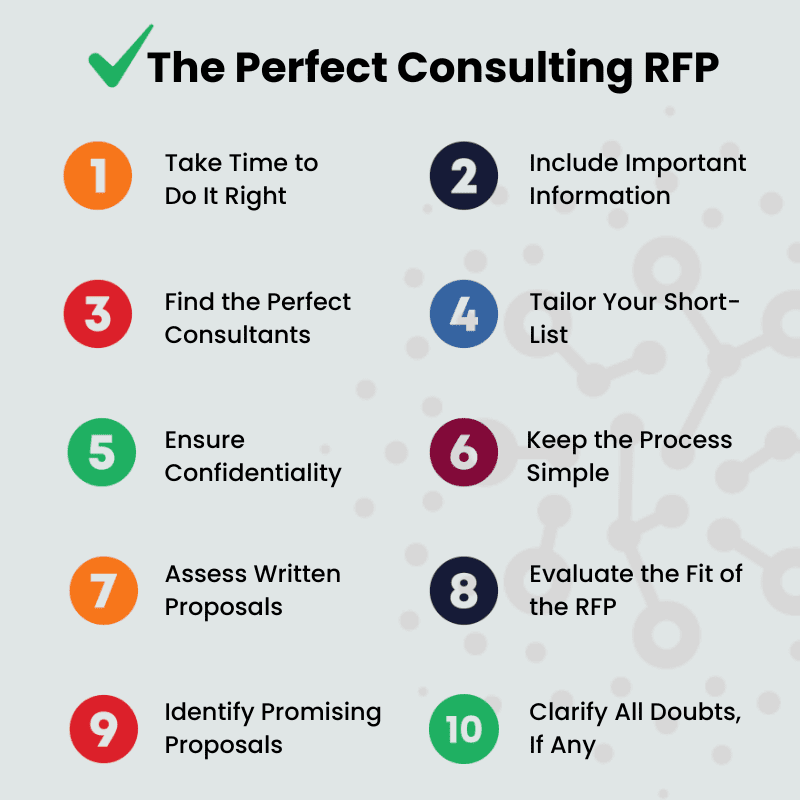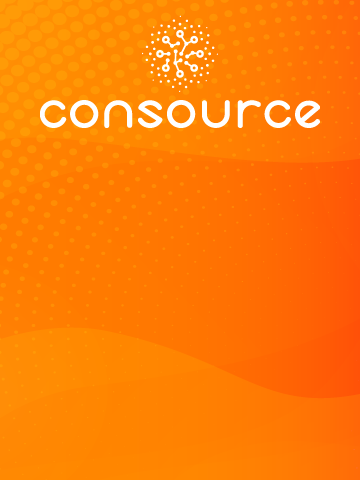Just as a script breathes life into a film, a perfect consulting RFP sets the stage for the grand performance of your project. Alfred Hitchcock, the maestro of suspense, once remarked, “To make a great film, you need three things – the script, the script, and the script.” In the world of consulting, it’s the RFP that plays this starring role.
An exceptional RFP isn’t merely an instruction manual. It’s the compass guiding your project, painting a vivid picture of your challenges, needs, and aspirations. Its ultimate aim? To find that perfect partner, a consultant who resonates with your vision, uniquely tailored for your journey.
So, how do you craft a perfect consulting RFP that captivates and conveys? Dive into our curated list of the Top 10 secrets to the perfect consulting RFP and set your project on the path to box-office success. Because in consulting, as in film, the right beginning makes all the difference.
1. Taking the Time to Do It Right
Creating the perfect consulting RFP is more than just putting words on paper; it’s a reflection of your business needs and a call to potential partners. Many RFPs for consulting are done hastily, resulting in overlooked details or vague contexts. This makes it challenging for consulting firms, especially newcomers, to gauge the problem and deliver a robust proposal.
Missing out on key requirements, ambiguous language, or not providing a clear pricing framework can hinder potential consultants from fully understanding and responding effectively. So, it’s essential to dedicate the necessary time and effort to develop an RFP that’s both comprehensive and clear.
2. Including the Important Information
The RFP isn’t just a formality; it’s the blueprint for the entire consulting engagement, and it plays a pivotal role in ensuring a perfect consulting RFP process. It’s crucial to paint a full picture so consultants can align their strategies with your expectations. Remember, the clearer your RFP, the more accurate and tailored the proposals you receive will be.
Your perfect consulting RFP should be comprehensive and include vital details such as:
Client Overview: Give a brief about your organization, its history, and what makes it unique. This helps consultants grasp your ethos and tailor their approach accordingly.
Project Context: Explain the backdrop against which this project is set. What led to the need for this consulting service? Any recent changes or challenges?
Scope and Deliverables: Clearly delineate the expected outcomes. What are the boundaries of the project? What are the tangible results you hope to see?
Timeline and Budget: Define the project’s start and end dates and any milestones in between. Provide a budget range to set financial expectations upfront.
Selection Process: Lay out the steps in your decision-making journey. How will you review proposals, and what’s the timeframe for finalizing your consultant choice?
Decision Criteria: Make it clear what you value most – is it experience, cost, innovation, or something else? This will guide consultants in emphasizing these areas in their proposals.
Requirements: Are there any mandatory qualifications or credentials? Maybe specific tools or methodologies you want them to use? Mention them.
Proposal Content: Offer guidance on what you expect in the response. Do you want case studies, team bios, or a detailed work plan?
The more transparent and detailed you are about your organization and project needs, the better equipped consulting providers will be to present a proposal that hits the mark. This clarity not only simplifies their task but also ensures you get the best-fit solutions for your challenges.
3. Finding the Perfect Consultants
Once your RFP is crafted meticulously, the next step is identifying the right consultants. While impressive portfolios and notable expertise can be enticing, what truly matters is selecting someone who aligns with the results you outlined in your RFP.
Remember, working with a renowned brand does not always equate to getting the desired results. It’s not always about the shine of the brand but about the substance and relevance of the consultant to your specific needs.
Consider the following while making your decision:
Results-Driven Approach: The primary objective is to achieve the outcomes you’ve specified in your RFP. The consultant should have a track record of delivering those results, even if they’re not from a ‘big name’ firm.
Fit with Your Organization: The best consultant in a particular field might not necessarily gel with your organizational culture or understand its nuances. You need someone who can seamlessly integrate, understand the ethos, and work collaboratively with your team.
Relationship and Trust: A successful consulting relationship is built on trust. You need to feel confident in their recommendations and their understanding of your needs. It’s a two-way street; they should also feel that they can communicate openly and candidly with you.
Budget Considerations: While expertise is paramount, the price point is undeniably a factor. Strive for a balance between cost and value. Remember, the cheapest option is not always the most cost-effective in the long run.
The best choice is a consultant who offers a harmonious blend of the right skills, the right fit, and a price point that aligns with your budget. Always aim for a consultant who resonates with your vision and can drive you closer to your goals.
4. Tailoring Your Short-list: Balancing Budget and Timeline
Look closely at the scope of the project, the budget, and the internal procurement policies to define your criteria of selection for the short-list. Be mindful of your time and adapt the length of your short-list to the level of priority and the budget of your project.
For smaller projects –
When you have a very tight timeline or for small projects with limited impact on your business, prefer a small short-list too so you can spend enough time on the proposal and the references checking. We recommend to not go beyond three prospective providers.
For larger projects –
you can broaden the first round (briefing/proposal phase) to up to ten consulting firms (depending on the project and the stakes) but keep at most four-five companies for the final round (pitching phase).
When your short-list is ready, contact your suppliers and check their interest by sending your Consulting RFP
5. Ensuring Confidentiality
It is important always to protect your confidential information, especially when you are preparing the perfect consulting RFP. Don’t hesitate to make your candidates sign a confidentiality agreement at the beginning (even at RFI or RFP stage) to protect proprietary information and make sure the consulting firms will not be sharing your project’s details with your competitors.
If the proposal includes collaboration and sub-contracting, make sure that an NDA legally binds all the contributors on the project. If your project is particularly confidential, you should even consider working with a third-party sourcing company, like Consulting Quest, that will handle the process anonymously. They will keep your company and your project confidential until the short-list stage.

6. Keeping the Perfect Consulting RFP Process Very Simple
And it’s best to make things simple. Unless you are handling a multi-million dollar project, don’t organize extravagant tenders. Looking through proposals and listening to consultants’ pitches can be extremely time-consuming. It will also considerably slow down your project. Make sure that your RFP process is adapted to the scope and the budget for your project.
If you only have a small number of consulting firms, or if the project is specifically complex, you might want to organize briefings to discuss the details of the project and make sure the consultants have well-understood what is at stake.
If you have a large number of candidates, a clear Consulting RFP, and little time on your hands, you can just send the RFP and assess the written proposals to identify the most promising one for the next step.
7. Assessing the Written Proposals
Once you have received the proposals, take the time to review them with the other stakeholders. Always keep your objective in mind: maximizing the chances of success of your project. You need the candidates to submit their best proposals, and for that, they need to understand the problem very well.
Level the ground, so all companies have a fair chance in the competition. It is in your best interest to do so too. Don’t hesitate to explain in length the background of your company, and the context of the assignment, and to take some time to polish the Q&A documents.
8. Evaluating the Fit with Your RFP
Make sure the candidates have responded to the most important elements in your RFP. Their proposals should help you answer the following questions:
- Has the consultant understood our objectives?
- Do the deliverables answer our questions?
- Do we trust the approach the consulting provider proposes?
- Does the team have the required experience?
- Is this consultant the right fit for you?
- Does the budget fit the value we expect?
Note if there are any gray areas and potential for misunderstanding.
9. Identifying the Most Promising Proposals
In the sea of proposals, it’s essential for time-strapped executives to strategize their evaluation process. Consulting firms are numerous, but not all proposals will align with your core objectives or offer the value you’re looking for.
Here’s a guided approach for a smarter selection process:
First Impressions Matter: While diving deep into every proposal is ideal, busy schedules might not allow it. Start by skimming through each proposal for clarity, alignment with your RFP, and the provider’s understanding of your needs. This quick assessment can filter out many non-aligning proposals.
Use a Grading System: Streamline your evaluation process by ranking proposals based on critical dimensions like objectives, deliverables, approach, experience, fit, and budget. Assign weightage to each category depending on its significance to your project. For example, if the budget is a primary concern, give it a higher weightage. This system helps in quantifying and comparing proposals effectively.
Respect the Consultant’s Time and Effort: Remember, behind every proposal is a consultant or a team that has invested time and effort. If a proposal is clearly off the mark, it’s considerate to inform them promptly. Not only does this save their time, but it also upholds your organization’s reputation for being respectful and professional.
By being smart and strategic in your approach, you not only save your own time but also ensure that you’re focusing on the proposals that have the highest potential to meet your needs. This approach allows for efficient decision-making and respects the efforts of all involved parties.
10. Clarifying Doubts
Choosing the right consultant goes beyond the confines of a written proposal, especially when crafting the perfect consulting RFP. Understanding their perspective and ensuring compatibility is pivotal. While the initial proposal provides insight, it may not capture the complete picture or address all nuances.
Engaging in a direct conversation has multiple benefits. It offers consultants an opportunity to refine their offerings based on real-time feedback. This interpersonal interaction allows you to gauge the dynamics between your team and the consultant. A successful partnership is built on mutual understanding and synergy, not just expertise.
Relying solely on written submissions might inadvertently favor consultants already familiar with your organization, potentially sidelining fresh perspectives. By fostering open dialogue, you level the playing field and ensure a comprehensive evaluation. Essentially, direct conversations refine the selection process, aligning it closely with your project’s objectives and fostering a productive collaboration.
Crafting the Encore: Perfecting Your Consulting RFP’s Final Act
In the world of film, the conclusion leaves a lasting impression, tying together all the story’s threads and evoking emotions that linger. Similarly, a meticulously designed consulting RFP ensures that the unfolding of your project narrative is impactful, coherent, and aligned with your goals for the perfect consulting RFP.
Through the lens of our top 10 secrets, the RFP becomes more than just a document; it’s a bridge, connecting your organization’s aspirations with the expertise of the right consultant for the perfect consulting RFP. It’s about harmonizing visions, ensuring that both parties dance to the same rhythm, creating a symphony of success.
As the curtains fall on our guide for the perfect consulting RFP, remember this: Just like a blockbuster film, the magic lies in the details. Invest in crafting your RFP with precision, passion, and clarity, and you’ll not only find the perfect consulting partner but also pave the way for a project that truly shines. Here’s to the standing ovations and encores that await!
perfect consulting rfp perfect consulting rfp perfect consulting rfp perfect consulting rfp
perfect consulting rfp perfect consulting rfp perfect consulting rfp perfect consulting rfp
perfect consulting rfp perfect consulting rfp perfect consulting rfp perfect consulting rfp

How Consource Can Help?
With Consource at your side, RFP creation becomes a seamless experience. Our platform enhances collaboration, offers content flexibility, and integrates industry best practices right into the process. Dive into Consource and elevate your RFP game!








0 Comments